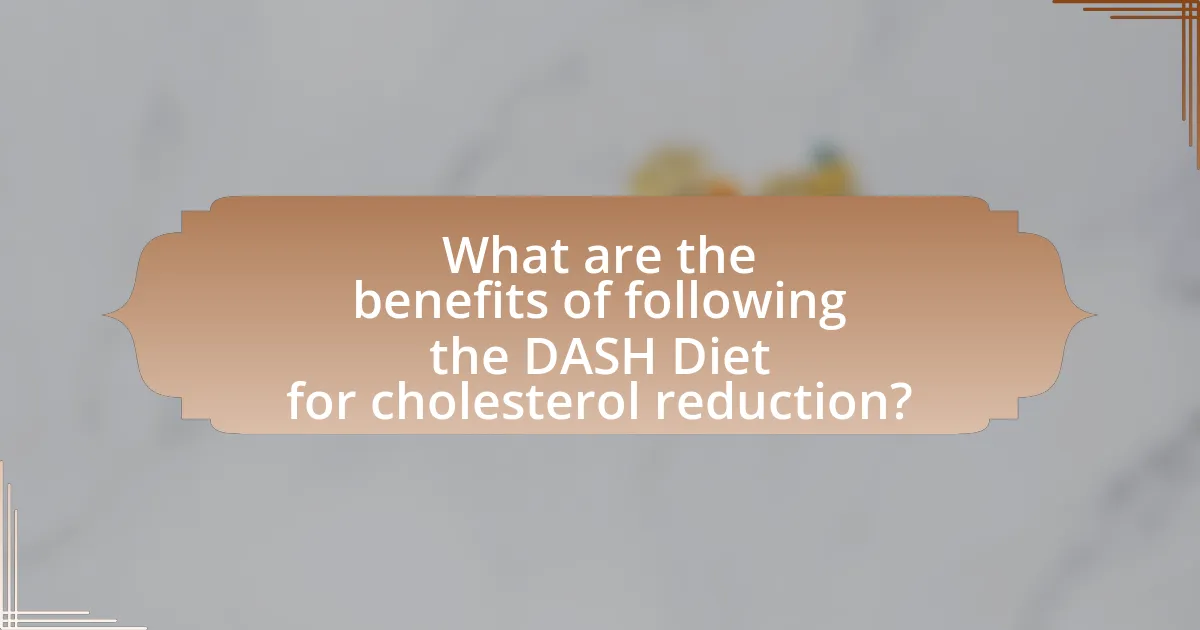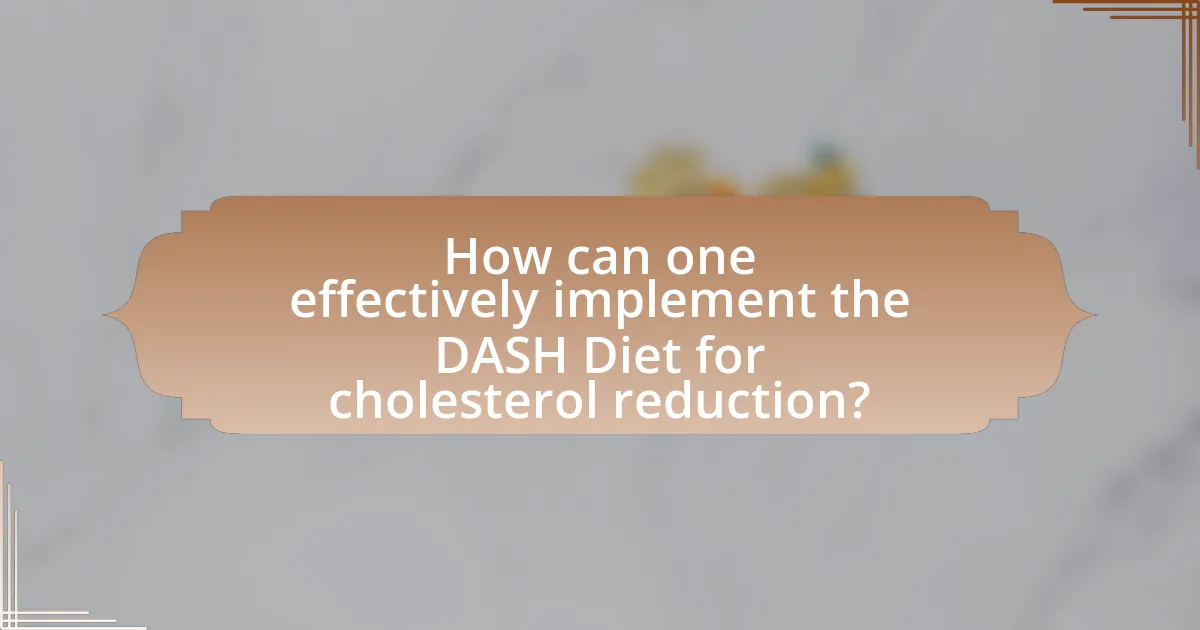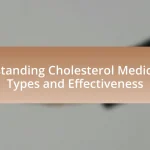The DASH Diet, or Dietary Approaches to Stop Hypertension, is a dietary plan aimed at reducing blood pressure and improving heart health through the consumption of fruits, vegetables, whole grains, lean proteins, and low-fat dairy while minimizing saturated fats, cholesterol, and sodium. Research indicates that adherence to the DASH Diet can lead to significant reductions in LDL cholesterol levels, with studies showing decreases of approximately 10% to 15% within weeks. Developed in the 1990s through NIH-funded research, the DASH Diet emphasizes balanced nutrition and has been proven effective in promoting cardiovascular health. Key principles include specific portion sizes and nutrient-rich food choices that support cholesterol management and overall heart wellness.

What is the DASH Diet and how does it relate to cholesterol reduction?
The DASH Diet, or Dietary Approaches to Stop Hypertension, is a dietary plan designed to reduce blood pressure and improve overall heart health. This diet emphasizes the consumption of fruits, vegetables, whole grains, lean proteins, and low-fat dairy while reducing saturated fats, cholesterol, and sodium. Research indicates that following the DASH Diet can lead to significant reductions in LDL cholesterol levels, which is a key factor in cardiovascular disease. A study published in the American Journal of Clinical Nutrition found that participants adhering to the DASH Diet experienced a reduction in total cholesterol and LDL cholesterol by approximately 10% to 15% over eight weeks. This evidence supports the effectiveness of the DASH Diet in promoting heart health and reducing cholesterol levels.
How was the DASH Diet developed?
The DASH Diet was developed through research funded by the National Institutes of Health (NIH) in the 1990s, specifically aimed at reducing hypertension. The study, known as the DASH (Dietary Approaches to Stop Hypertension) trial, involved a controlled feeding study where participants followed different dietary patterns. The findings demonstrated that a diet rich in fruits, vegetables, whole grains, and low-fat dairy significantly lowered blood pressure compared to a typical American diet high in saturated fats and sugars. This evidence-based approach established the DASH Diet as an effective strategy for not only managing hypertension but also promoting overall heart health.
What research supports the effectiveness of the DASH Diet?
Research supporting the effectiveness of the DASH Diet includes a study published in the New England Journal of Medicine, which demonstrated that participants following the DASH Diet experienced significant reductions in blood pressure compared to those on a control diet. The study, conducted by Appel et al. in 1997, involved 459 participants and showed that the DASH Diet, rich in fruits, vegetables, and low-fat dairy, led to an average decrease in systolic blood pressure of 5.5 mm Hg and diastolic blood pressure of 3.0 mm Hg. Additionally, a meta-analysis published in the American Journal of Hypertension in 2014 confirmed that adherence to the DASH Diet is associated with lower cholesterol levels and improved cardiovascular health outcomes. This evidence collectively underscores the DASH Diet’s effectiveness in promoting heart health and reducing cholesterol levels.
What are the key principles of the DASH Diet?
The key principles of the DASH Diet include emphasizing fruits, vegetables, whole grains, and lean proteins while reducing sodium intake and limiting saturated fats and added sugars. This dietary approach aims to lower blood pressure and improve heart health, supported by research from the National Heart, Lung, and Blood Institute, which indicates that the DASH Diet can significantly reduce hypertension and cholesterol levels. The diet encourages a balanced intake of nutrients, promoting foods rich in potassium, calcium, and magnesium, which are essential for cardiovascular health.
What are the main components of the DASH Diet?
The main components of the DASH Diet include fruits, vegetables, whole grains, lean proteins, and low-fat dairy. This dietary approach emphasizes the consumption of nutrient-rich foods while reducing sodium intake to help lower blood pressure and improve heart health. Research published in the “New England Journal of Medicine” by Sacks et al. (2001) demonstrated that adherence to the DASH Diet significantly reduced systolic and diastolic blood pressure, supporting its effectiveness in promoting cardiovascular health.
What types of foods are included in the DASH Diet?
The DASH Diet includes a variety of foods that emphasize fruits, vegetables, whole grains, lean proteins, and low-fat dairy. Specifically, it encourages the consumption of at least four to five servings of fruits and four to five servings of vegetables daily, along with six to eight servings of whole grains. Lean meats, poultry, and fish should be limited to no more than two servings per day, while nuts, seeds, and legumes are recommended four to five times a week. Additionally, the diet advises reducing saturated fats and cholesterol by choosing low-fat or fat-free dairy products and minimizing processed foods high in sodium. This food composition is designed to lower blood pressure and improve overall heart health, aligning with the diet’s primary goal of reducing cholesterol and promoting cardiovascular wellness.
How does the DASH Diet recommend portion sizes?
The DASH Diet recommends specific portion sizes to promote heart health and reduce cholesterol. It suggests consuming a variety of food groups in controlled amounts, such as 6-8 servings of grains, 4-5 servings of vegetables, 4-5 servings of fruits, 2-3 servings of low-fat dairy, 2 or fewer servings of lean meats, and limited amounts of fats and sweets. This structured approach is designed to provide balanced nutrition while keeping sodium intake low, typically under 2,300 mg per day, or ideally 1,500 mg for greater health benefits. The portion sizes are based on a daily caloric intake of about 2,000 calories, which is a standard reference for dietary guidelines.
What is the relationship between the DASH Diet and cholesterol levels?
The DASH Diet is associated with lower cholesterol levels. Research indicates that adherence to the DASH Diet, which emphasizes fruits, vegetables, whole grains, and lean proteins while reducing saturated fats, can lead to significant reductions in total cholesterol and LDL cholesterol levels. A study published in the American Journal of Clinical Nutrition found that participants following the DASH Diet experienced a reduction in LDL cholesterol by approximately 11 mg/dL compared to those on a standard diet. This evidence supports the effectiveness of the DASH Diet in managing cholesterol levels.
How does the DASH Diet impact LDL and HDL cholesterol?
The DASH Diet significantly lowers LDL cholesterol and raises HDL cholesterol levels. Research indicates that individuals adhering to the DASH Diet experience a reduction in LDL cholesterol by approximately 11 to 15 mg/dL, which is associated with a decreased risk of cardiovascular disease. Additionally, the diet’s emphasis on fruits, vegetables, whole grains, and healthy fats contributes to an increase in HDL cholesterol, often referred to as “good” cholesterol, which helps remove LDL cholesterol from the bloodstream. Studies, such as those published in the American Journal of Clinical Nutrition, have demonstrated these effects, confirming the DASH Diet’s efficacy in improving overall cholesterol profiles.
What role do specific nutrients in the DASH Diet play in cholesterol management?
Specific nutrients in the DASH Diet, such as fiber, potassium, and healthy fats, play a crucial role in cholesterol management. Fiber helps lower LDL cholesterol levels by binding to cholesterol in the digestive system, facilitating its excretion. Potassium, found in fruits and vegetables, supports heart health and can help lower blood pressure, which is beneficial for overall cardiovascular health. Healthy fats, particularly those from sources like nuts and olive oil, can improve lipid profiles by increasing HDL cholesterol while lowering LDL cholesterol. Studies have shown that adherence to the DASH Diet can lead to significant reductions in total cholesterol and LDL cholesterol levels, reinforcing the effectiveness of these nutrients in managing cholesterol.

What are the benefits of following the DASH Diet for cholesterol reduction?
The DASH Diet significantly benefits cholesterol reduction by promoting the intake of fruits, vegetables, whole grains, and lean proteins while limiting saturated fats and cholesterol. This dietary pattern has been shown to lower LDL cholesterol levels, which is a key factor in reducing the risk of heart disease. Research published in the Journal of the American College of Cardiology indicates that individuals adhering to the DASH Diet can experience a reduction in total cholesterol by approximately 10% and LDL cholesterol by about 15% within a few weeks. These changes are attributed to the diet’s high fiber content and low saturated fat intake, which collectively improve lipid profiles and enhance overall cardiovascular health.
How does the DASH Diet contribute to overall heart health?
The DASH Diet contributes to overall heart health by emphasizing the consumption of fruits, vegetables, whole grains, and lean proteins while reducing sodium intake. This dietary pattern helps lower blood pressure, a significant risk factor for heart disease, as evidenced by research published in the Journal of the American College of Cardiology, which found that participants following the DASH Diet experienced a reduction in systolic blood pressure by an average of 5.5 mm Hg and diastolic blood pressure by 3.0 mm Hg. Additionally, the diet’s focus on nutrient-rich foods provides essential vitamins and minerals that support cardiovascular function, further enhancing heart health.
What are the long-term health benefits of the DASH Diet?
The long-term health benefits of the DASH Diet include significant reductions in blood pressure, improved heart health, and lower cholesterol levels. Research indicates that adherence to the DASH Diet can lead to a 5-10 mmHg decrease in systolic blood pressure, which is crucial for reducing the risk of cardiovascular diseases. Additionally, studies have shown that the diet, rich in fruits, vegetables, whole grains, and low-fat dairy, can lower LDL cholesterol levels by approximately 10-15%. This dietary approach not only promotes weight management but also enhances overall metabolic health, contributing to a lower risk of type 2 diabetes and stroke.
How does the DASH Diet compare to other diets for cholesterol management?
The DASH Diet is more effective for cholesterol management compared to many other diets, particularly due to its emphasis on whole foods, fruits, vegetables, and low-fat dairy. Research indicates that individuals following the DASH Diet can experience a significant reduction in LDL cholesterol levels, with studies showing reductions of approximately 11 to 15 mg/dL in just eight weeks. In contrast, diets high in saturated fats, such as the ketogenic diet, often lead to increased cholesterol levels. The DASH Diet’s focus on reducing sodium intake and increasing fiber intake contributes to its effectiveness in lowering cholesterol, making it a preferred choice for heart health.
What challenges might individuals face when starting the DASH Diet?
Individuals may face several challenges when starting the DASH Diet, including difficulty in meal planning, adjusting to new food choices, and managing cravings for high-sodium or high-sugar foods. Meal planning can be complex due to the need to incorporate a variety of fruits, vegetables, whole grains, and lean proteins while avoiding processed foods. Adjusting to new food choices often requires individuals to change long-standing eating habits, which can be uncomfortable and lead to resistance. Additionally, cravings for familiar, less healthy foods may persist, making adherence to the diet challenging. These challenges can hinder the successful implementation of the DASH Diet, which is designed to lower blood pressure and improve overall health.
How can individuals overcome common obstacles to following the DASH Diet?
Individuals can overcome common obstacles to following the DASH Diet by planning meals in advance, incorporating a variety of foods, and gradually making dietary changes. Meal planning helps individuals avoid impulsive eating and ensures they have DASH-compliant foods readily available. Including a diverse range of fruits, vegetables, whole grains, and lean proteins can make the diet more enjoyable and sustainable. Gradual changes, such as slowly reducing sodium intake and increasing potassium-rich foods, can ease the transition and make adherence easier. Research indicates that structured meal planning and gradual dietary adjustments significantly improve adherence to dietary guidelines, enhancing overall health outcomes.
What resources are available to support individuals on the DASH Diet?
The resources available to support individuals on the DASH Diet include official dietary guidelines, meal planning tools, cookbooks, and online support communities. The National Heart, Lung, and Blood Institute provides comprehensive resources, including a DASH Diet eating plan and recipes that emphasize fruits, vegetables, whole grains, and lean proteins. Additionally, the American Heart Association offers educational materials and tips for following the DASH Diet effectively. Research studies, such as those published in the Journal of the American College of Cardiology, demonstrate the diet’s effectiveness in reducing cholesterol levels, further validating the importance of these resources for individuals seeking to improve their heart health.

How can one effectively implement the DASH Diet for cholesterol reduction?
To effectively implement the DASH Diet for cholesterol reduction, one should focus on consuming a variety of nutrient-rich foods while limiting saturated fats and cholesterol. This includes increasing intake of fruits, vegetables, whole grains, lean proteins, and low-fat dairy products, while reducing processed foods, red meats, and added sugars. Research indicates that adherence to the DASH Diet can lower LDL cholesterol levels by an average of 11 points within just a few weeks, as demonstrated in studies published in the American Journal of Clinical Nutrition. By following these dietary guidelines, individuals can significantly improve their cholesterol levels and overall heart health.
What practical tips can help in meal planning for the DASH Diet?
Practical tips for meal planning on the DASH Diet include focusing on whole foods, incorporating a variety of fruits and vegetables, selecting lean proteins, and choosing whole grains. Whole foods, such as fresh produce and unprocessed items, provide essential nutrients while minimizing sodium intake, which is crucial for the DASH Diet’s effectiveness in reducing cholesterol. Aiming for at least four to five servings of fruits and vegetables daily ensures a rich intake of vitamins, minerals, and fiber, which support heart health. Lean proteins, such as poultry, fish, and legumes, should replace red meats to lower saturated fat consumption. Additionally, whole grains like brown rice and whole wheat bread are recommended over refined grains, as they contribute to better cholesterol levels and overall health. These strategies align with the DASH Diet’s guidelines, which emphasize nutrient-rich foods to promote cardiovascular wellness.
How can one incorporate DASH Diet principles into everyday meals?
To incorporate DASH Diet principles into everyday meals, focus on consuming a variety of fruits, vegetables, whole grains, lean proteins, and low-fat dairy while reducing sodium intake. For instance, include at least four to five servings of fruits and vegetables daily, such as berries, leafy greens, and carrots, which are rich in nutrients and fiber. Whole grains like brown rice and quinoa should replace refined grains, providing essential nutrients and promoting heart health. Lean proteins, such as chicken, fish, and legumes, should be prioritized over red meats, while low-fat dairy options like yogurt and milk can help meet calcium needs without excess saturated fat. Additionally, limit sodium to 2,300 mg per day, or ideally 1,500 mg, by using herbs and spices for flavor instead of salt. Research indicates that following these guidelines can significantly lower blood pressure and improve overall cardiovascular health, aligning with the DASH Diet’s goals for cholesterol reduction.
What are some easy recipes that align with the DASH Diet?
Some easy recipes that align with the DASH Diet include a quinoa salad with mixed vegetables, baked salmon with herbs, and a vegetable stir-fry with brown rice. Quinoa salad combines whole grains and vegetables, providing fiber and essential nutrients, which are key components of the DASH Diet aimed at reducing cholesterol. Baked salmon is rich in omega-3 fatty acids, known to support heart health, while the vegetable stir-fry offers a variety of colorful vegetables, promoting a low-sodium, nutrient-dense meal. These recipes are simple to prepare and adhere to the DASH Diet’s emphasis on whole foods, low sodium, and healthy fats.
What are the best practices for maintaining the DASH Diet long-term?
To maintain the DASH Diet long-term, individuals should focus on consistent meal planning, incorporating a variety of fruits, vegetables, whole grains, lean proteins, and low-fat dairy. This approach ensures a balanced intake of essential nutrients while adhering to the diet’s guidelines. Research indicates that individuals who regularly plan meals are more successful in sticking to dietary patterns, as it reduces impulsive eating and promotes healthier choices. Additionally, monitoring sodium intake to remain within the recommended limits of 1,500 to 2,300 milligrams per day is crucial for managing blood pressure and overall health. Engaging in regular physical activity, such as 150 minutes of moderate exercise weekly, complements the DASH Diet and enhances its effectiveness in reducing cholesterol levels.
How can one track progress while following the DASH Diet?
To track progress while following the DASH Diet, individuals should regularly monitor their blood pressure, weight, and dietary adherence. Blood pressure measurements can indicate the effectiveness of the diet in reducing hypertension, which is a primary goal of the DASH Diet. Studies show that the DASH Diet can lower systolic blood pressure by an average of 5 to 6 mmHg within a few weeks of adherence. Additionally, keeping a food diary helps individuals assess their compliance with the diet’s guidelines, ensuring they consume the recommended servings of fruits, vegetables, whole grains, and lean proteins. Regular weigh-ins can also provide insight into weight management, which is crucial for overall health and cholesterol reduction.
What strategies can help sustain motivation on the DASH Diet?
To sustain motivation on the DASH Diet, individuals can set specific, achievable goals and track their progress. Research indicates that goal-setting enhances commitment and accountability, which are crucial for long-term adherence to dietary changes. Additionally, incorporating a variety of foods within the DASH framework can prevent monotony and increase enjoyment, making it easier to stick to the diet. Social support, such as joining a group or involving family members, has also been shown to improve motivation and adherence, as shared experiences can foster encouragement and accountability.
What are the common misconceptions about the DASH Diet?
Common misconceptions about the DASH Diet include the belief that it is solely a weight loss plan and that it is too restrictive. The DASH Diet, which stands for Dietary Approaches to Stop Hypertension, primarily aims to lower blood pressure and improve heart health rather than focusing exclusively on weight loss. Additionally, while it emphasizes fruits, vegetables, whole grains, and lean proteins, it does not eliminate entire food groups but rather encourages moderation and balance. Research published in the Journal of the American Dietetic Association indicates that the DASH Diet can be sustainable and enjoyable, debunking the notion that it is overly restrictive.
How can one differentiate between facts and myths regarding the DASH Diet?
To differentiate between facts and myths regarding the DASH Diet, one should rely on evidence-based research and credible sources. The DASH Diet, which stands for Dietary Approaches to Stop Hypertension, is scientifically supported for its effectiveness in reducing blood pressure and improving heart health, as demonstrated in studies published by the National Institutes of Health. For instance, a study in the New England Journal of Medicine found that participants following the DASH Diet experienced significant reductions in blood pressure compared to those on a standard diet. Myths often arise from anecdotal claims or misinterpretations of dietary guidelines, so consulting peer-reviewed articles and guidelines from reputable organizations like the American Heart Association can clarify misconceptions.
What should individuals know before starting the DASH Diet?
Individuals should know that the DASH Diet, which stands for Dietary Approaches to Stop Hypertension, emphasizes the consumption of fruits, vegetables, whole grains, and lean proteins while reducing sodium intake. This diet is designed to lower blood pressure and improve heart health, making it beneficial for cholesterol reduction. Research published in the Journal of the American College of Cardiology indicates that adherence to the DASH Diet can lead to significant reductions in LDL cholesterol levels, which is a key factor in cardiovascular health. Therefore, individuals should be prepared to make dietary changes that align with these principles for optimal results.










